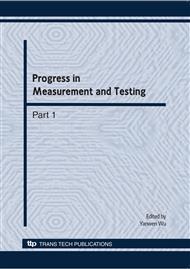[1]
Zhu Y M, Li X R. Unified fusion rules in the multi-sensor multi-hypothesis network decision systems. IEEE Transactions on Systems, Man and Cybernetics, Part A, 2003, 33(4): 502~513.
DOI: 10.1109/tsmca.2003.809211
Google Scholar
[2]
Zhu Y M, Song E B, Zhou J, et al Optimal dimensionality reduction of sensor data in multi-sensor estimation fusion. IEEE Transactions on Signal Processing, 2005, 53(5): 1631~1639.
DOI: 10.1109/tsp.2005.845429
Google Scholar
[3]
Song Sh P, Que P W, Zhang W Y. Design of Line-focusing Ultrasonic Transducer Array Used for Flaw Detection in Seabed Pipelines. Chinese Journal of Scientific Instrument, 2006, 27(5): 547 ~550. (in Chinese).
Google Scholar
[4]
Sun S L. Distributed optimal component fusion weighted by scalars for fixed-lag Kalman smoother. Automatica, 2005, 41(12): 2153~2159.
DOI: 10.1016/j.automatica.2005.06.014
Google Scholar
[5]
Ghasem Mirjalily. Blind Adaptive Decision Fusion for Distributed Detection. IEEE Transactions on Aerospace and Electronic Systems, 2003, 39(1): 34~51.
DOI: 10.1109/taes.2003.1188892
Google Scholar
[6]
Han Ch Zh, Zhu H Y. Multi-sensor information fusion and automation. Acta Automaticsa Sinica, 2002, (28): 117~124. (in Chinese).
Google Scholar
[7]
Liu Y, Gao X G, Lu G Sh, et al. Weighted Attribute Information Fusion Based on OWA Aggregation Operator. Chinese Journal of Scientific Instrument, 2006, 27(3): 322~325. (in Chinese).
Google Scholar
[8]
Zhang M H, Ding Zh H, Bai Y. Study on multi-sensor fusion technology in naval ships chemical detection system. Chinese Journal of Scientific Instrument, 2006, 27(12 Supp. ): 119~123. (in Chinese).
Google Scholar
[9]
Luo Z Q. Universal decentralized estimation in a bandwidth constrained sensor network. IEEE Transactions on Information Theory, 2005, 51(6): 2210~2219.
DOI: 10.1109/tit.2005.847692
Google Scholar
[10]
Feng Zh Q, Yang Y H. Fusion recognition of dot target multi-spectrum data based on ANN. Optics and Precision Engineering, 2003, 11(4): 412~415. (in Chinese).
Google Scholar
[11]
Wang L G, Zhang L H, Kang J L. Study on the neural networks for distinguishing chemical agents based on the wavelet analysis. Transactions of Beijing Institute of Technology, 2006, 26(2): 120~124. (in Chinese).
Google Scholar
[12]
Zhang M H, Pang G C, Liu H, et al. Chemical agent identification technology for naval ships chemical detection. Journal of Guangxi Normal University: Natural Science Edition, 2008, 26(1): 220~223. (in Chinese).
Google Scholar


